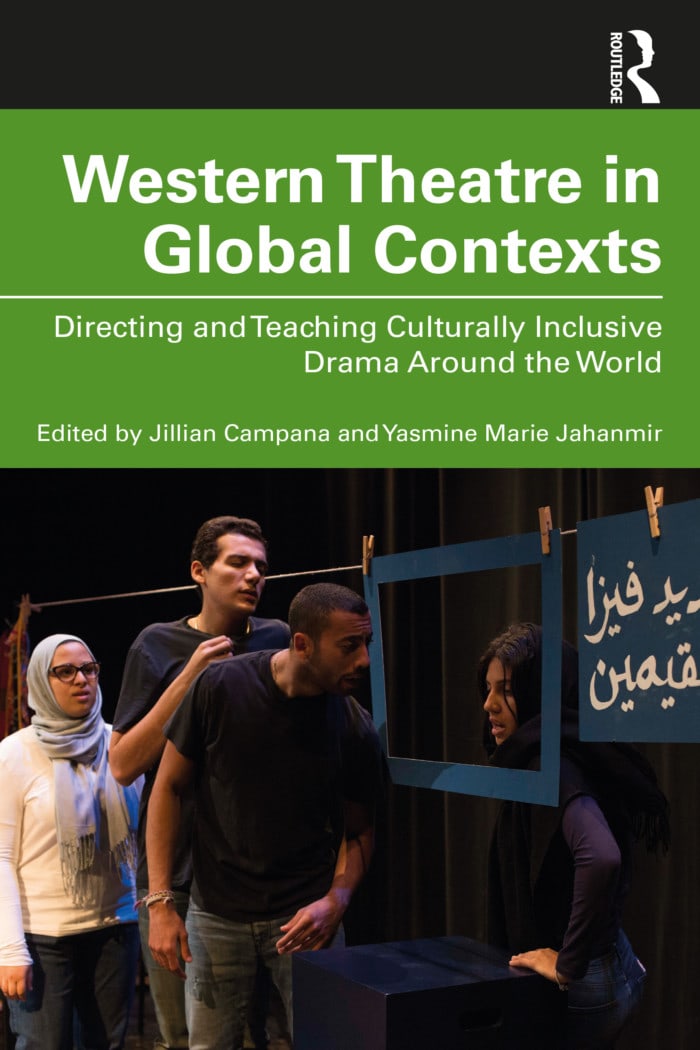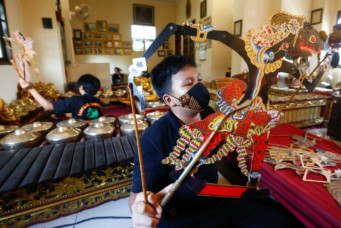Theater for All
How culturally inclusive theater that bears on both Western and Eastern experiences can produce citizens of the world and more global understanding.
Western Theatre in Global Contexts: Directing and Teaching Culturally Inclusive Drama Around the World, edited by Jillian Campana and Yasmine Marie Jahanmir, Routledge: New York & London, 2021.
In contemporary postcolonial times, many scholars from the Global North might shy away from sharing their perceptions of (and Western gaze onto) non-Western cultures. The history of colonialism, and its notorious cultural hegemonic practices of the past, possibly prevents scholars from making such opinions and haunts the undertaking of any such projects. However, in Western Theatre in Global Contexts: Directing and Teaching Culturally Inclusive Drama Around the World, editors Jillian Campana and Yasmine Marie Jahanmir, together with a number of scholars, are quite comfortable compiling and contributing articles that specifically tackles some of these challenging subject matter/s.
The pertinent question herein is whether in this day and age Western scholars and artists should keep unexpressed findings of their experiences and research about cultures of the Global South for fear of evaluative assumptions. Or should they brave the storm of suspicion that shrouds research concerned with developing cultures and ancient civilizations, which is usually expected to be condescending and neocolonial in nature. This appears to be a rather delicate situation.
Instead of being beset by such perceptions, Campana and Jahanmir face those arguments head-on with intellectual retort as they set out to engage with non-Western cultural traditions and dramatic aesthetics with grace, respect, enthusiasm, and most importantly, sincere inquiry. They state at the outset, “We hope to challenge artists and educators to expand the ways in which they teach, direct and facilitate Western theatre, to acknowledge and embrace the challenges and to listen to, learn from and work with the local communities.” Furthermore, their work does not approach the pedagogy, artistic productions, and the tradition of non-Western cultures from a structural binary prism. On the contrary, the editors pose the question of how best to decolonize educational curricula and fill “previous [colonial] gaps in pedagogy”. Thus, the articles that constitute the four parts of Western Theatre in Global Contexts ponder many of the in-between spaces that constitute transcultural knowledge as opposed to notions of difference and discord. A s Erika Fischer-Lischt, renowned dramatic theorist, puts it, interweaving cultural experiences can only produce “citizens of the world”.
Every chapter within Western Theatre in Global Contexts involves case studies of endeavors made by educators and artists in different parts of the globe to produce Western theater in non-Western regions. In the chapters, contributors self-reflect on the outcomes of their transcultural experiences. Notably, authors share both the successes and challenges that have arisen as a result of working on plays and introducing techniques steeped in Western tradition outside of the English-speaking world. While their experiences may be singular and personal, throughout the entire volume, they offer similar insights and have an obvious appreciation of multiculturalism.
This earnestness is a long shot from the Eurocentric snobbery of the past. The tone of the authors is often self-reflective and at times even critical of how Western pedagogy and tradition have continued to hold a reputation of superiority for as long as it did. In fact, one of the most interesting self-reflections is the authors’ implicit collective agreement that their transcultural experiences in theater were mutually enlightening, inspiring, and educational. And while it is a fact that Western theater, its techniques and practices, have had great influence on world theatrical performances for many reasons—coloniality (certainly) being the most evident one—its dominance is at times viewed with reprehension because it represents a form of cultural imperialism. Western Theatre in Global Contexts, however, transcends this complexity by underscoring that the interweaving of cultures supersedes political hegemony. After all, universal themes and common human experiences at the heart of Western arts are what continue to draw artists and educators from around the globe in spite of the inexcusable history of Western occupation.
Marvin Carlson asserts in Part I of the book, “Global Flows: Western Theatre in International Context,” that mastering Western languages and cultures today translates into power as it opens up job prospects and opportunities to individuals in the Global South. It is therefore no wonder that getting a Western education, outside of the Global North, is usually exorbitant as it aims to produce global citizens with higher linguistic abilities and training. In viewing the study of Western humanities as a gateway to finding better job opportunities, Carlson draws points of similarities and differences between students and practitioners of theater in both Egypt and China, and notes that in both countries Western-style theater continues to be elitist—presented by the Western educated and received by the equally Western cultured connoisseurs.
Part II, “International Stages: Western Theatre in Performance,” focuses on specific Western plays produced and performed in various regions of the Global South. While Campana explores the restrictions of censorship in Egypt, where she has directed Lysistrata (an ancient Greek comedy by Aristophanes about women withholding sex from men in order to motivate them to end the Peloponnesian War), Arnab Benerji engages with the topic of conservatism and introducing Western texts within non-Western cultures by discussing productions of Top Girls and the Knight and Burning Pestle in India. He states that adaptive twists, inversion of roles, as well as, adding Asian features have helped make those productions appealing to local cultures. Additionally, Jahanmir writes about the tribulations of casting the American musical drama West Side Story in Kuwait and explains the difficulties she has encountered when attempting to veer away from the Hollywood model of casting according to skin, color, and race.
In “Across a Cloudy Room: The Cultural Appropriation of Western Musicals by Chinese Students at the Expense of their National Identity: A Case Study,” James P. Marrione and Mei Song maintain that they have both exerted great efforts in finding an answer to why Chinese artists “engage exclusively with foreign material instead of their own cultural experience”. This has proved to be elusive according to the two authors and one that they concede could not be fully answered. On the other hand, armed with Edward Said’s assertion that, “No one today is purely one thing,” and with a strong inclination to listen to the opinions of his students of mixed nationalities, M. Tardi reveals his surprise when introducing a new course at his university in Oman in “How to Swim in the Desert: On Developing Theatre in Oman.” He recalls the remarkable zest with which he was met when he introduced practices in theater-making to a theoretical course that was merely meant to introduce readings of one-act plays.
In Part III of the book, entitled “Pedagogy Abroad: Western Theatre in Education,” five authors share their perspectives on presenting a variety of Western theatrical practices to non-Western students and audiences. Adam Christopher Marple reflects on his commitment to introduce Viewpoints, a theatrical technique that integrates movement with emotions and space to non-Western/non-English speaking students. He observes that using this technique in Singapore facilitated artistic communication and allowed him to transcend national diversity. Next Anne Drouet and Campana give an extensive overview of the founding, activities, and achievements of the collaboration between The International Schools Theatre Association (ISTA) and the performing arts academies in Shanghai and Hong Kong. They state that this partnership, “[which] focus[es] on collaborative devising across the artforms,” has invariably resulted in “developing interpersonal and communication skills, offering new insights across the art forms, stretching students in terms of personal and world values, encouraging individual and common goals, and fostering deep connections with others”. In the next chapter, Fenella Kelly comments on the benefits of teaching within the International Baccalaureate (IB) curriculum in many parts of the world, and notes that it fosters confidence and communication across cultures and grows internationally minded students through the study of theater. In “Collaborative Creations,” Anne Garcia-Romero describes the gratification that emerged from her artistic collaborations and devised performances with theater colleagues in Chile.
The final part of the book, entitled “Intercultural Exchanges: Theory and Practice,” is comprised of four chapters that revolve around successful theories that can be put into practice across borders. Selma Helal recalls instilling the “concepts of liberty, dignity and justice that define the Revolution [and that] materialize in the Post-Revolution Tunisia” by way of using classical Western dramatic texts. In post-colonial theater in Madagascar, Haddy Kreie writes about the complications that sometimes arise from integrating Western drama into non-Western political affairs for the purpose of drawing attention to the abuses of political and religious centers of power. Similarly, Sarah Roberts and Neka Da Costa share their creative process in producing Shakespeare’s Antony and Cleopatra for school pupils in Johannesburg. The last article in the book, “Intersections and Encounters,” by Lynne Kent lays out the details of interweaving Arab (Jordanian) and Australian puppetry traditions and the thrilling outcome of creating a hybrid theatrical experience.
In the conclusion, Campana and Jahanmir reflect on the wide range of pedagogies and artistic experiences expressed and shared by all the contributors of Western Theatre in Global Contexts: Directing and Teaching Culturally Inclusive Drama Around the World. Their final thoughts affirm the vital role of interconnecting art and education across continents, races, and nations in the twenty-first century. Without those connections, the world would continue on the regressive and divisive track of the past, when lack of knowledge about the other abetted the politics of oppression of those in power.
Dina Amin is associate professor of Theater and Director of the Theater Program at the American University in Cairo. She was General Director of CIFCET from 2014 to 2019. Amin is the author of Alfred Farag and Egyptian Theater, co-editor of Salaam: Anthology of Middle-Eastern-American Drama and From Orientalists to Arabists: The Shifts in Arabic Literary Studies, Journal of Arabic Literature.
Read More



